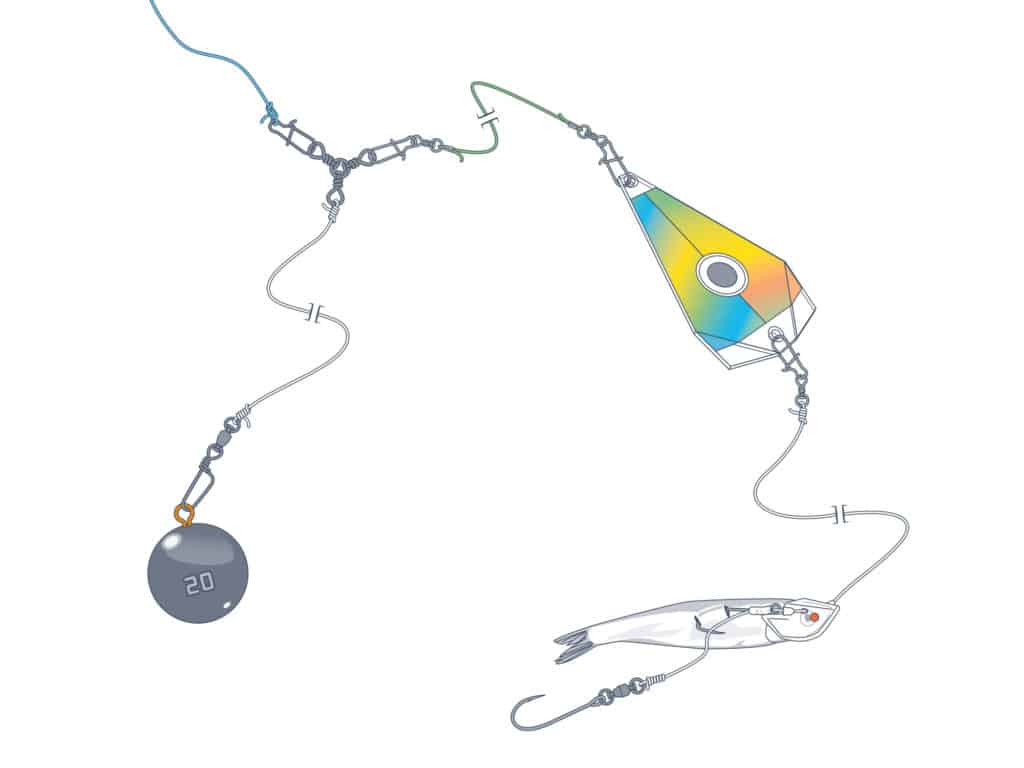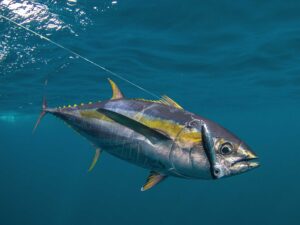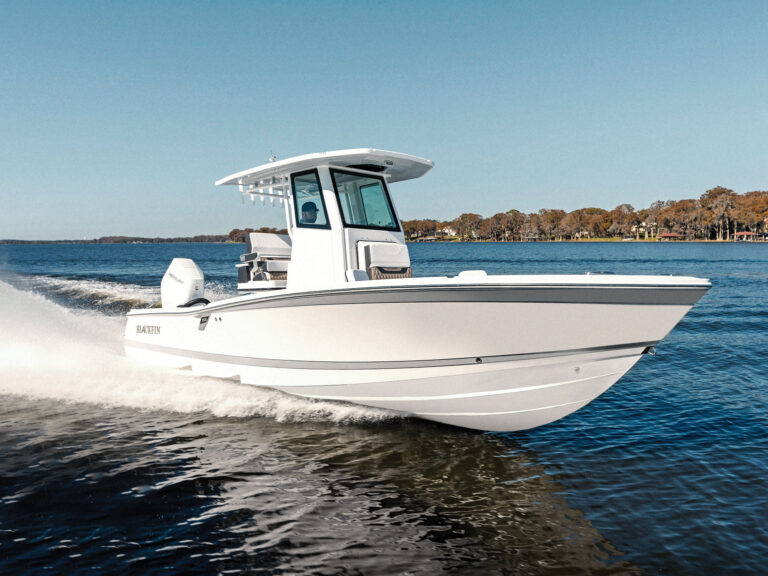Gray morning clouds hung low over the Columbia River mouth. From the deck of our 25-foot aluminum boat, I spied Cape Disappointment, where Lewis and Clark’s Corps of Discovery concluded its westward passage more than two centuries earlier. Now we fish for salmon on these waters.

Yet unlike Lewis and Clark, we were far from isolated. Hundreds of boats filled the river, often passing as close as a rod’s length from each other. I questioned the sanity of this so-called Buoy 10 fishery.
Doubts went “poof!” as my rod bent double, the clicker announced a hookup, and I felt the surge of a powerful salmon. Skipper Chad Normoyle maintained headway to keep the other lines straight and maintain our boat position in the fleet as I battled the fish.
Soon I glimpsed the chrome flanks of the salmon a few feet below, then Normoyle deftly scooped up a 25-pound king salmon. The iridescence of this king signified it had just entered the river from the ocean. Locals call these “upriver brights.”
Now I understood what Buoy 10 is all about.

Salmon Central
The staging area for the Buoy 10 season is the otherwise-quiet burg of Astoria, Oregon. Each August, anglers roll in by the thousands, turning Astoria into a boomtown and, for a brief time, Astoria becomes salmon central.
I joined the fray with Chris Russell, Shimano senior manager, Oregon native and lifelong participant in the Buoy 10 fishery.
“I love the Buoy 10 fishing,” he says as we drive into town. “There’s just nothing else like it in the world.”
Normoyle agrees. “I wouldn’t miss it,” he says, having fished it every year for the last two decades. When not fishing, Normoyle serves as a sales representative with Don Coffey Company. Also joining us was Jim Lebson, president of G. Loomis in nearby Woodland, Washington.
Buoy 10 Boundaries
This fishery is named for an unassuming channel marker at the mouth of the Columbia River marking the western boundary of the area where salmon fishing is allowed during this brief season.
The eastern boundary some 16 miles upriver, a line stretching from Tongue Point, Oregon, to Rocky Point on the Washington side, passes through red channel marker 44. The 4-mile-long Astoria-Megler Bridge spans the river between the boundaries.
The Buoy 10 season runs from August 1 through Labor Day, or until the catch quota is met. In 2015, record catch rates prompted fishery managers from Oregon and Washington to close the season on August 29, 11 days earlier than scheduled.
The total catch of king salmon — the most prized species among anglers participating in the Buoy 10 fishery — exceeded 35,000 fish during four weeks of fishing. Anglers could continue to keep hatchery-raised coho salmon and summer steelhead trout. Both species are marked as hatchery fish by a clipped adipose fin. Regulations prohibit anglers from retaining wild coho or steelhead.
For 2016, fishery managers are expecting 950,000 fall-run king salmon to enter the mouth of the Columbia. While fishery managers are less optimistic about the run of coho, the number of kings should result in another outstanding season.

Play it Safe
Columbia River Bar near the actual Buoy 10 is known as the Graveyard of the Pacific. Each year, fishing boats capsize or swamp while attempting to negotiate the bar as ocean swells roll in — a passage made even more treacherous when swells meet an outgoing tide.
Safe boating on the fast-flowing Columbia is critical. Strong winds often blow in from the Pacific in the afternoon. On days when wind opposes current, the confluence can turn this wide section of the river into a cauldron of steep, white-capping waves, forcing many boats into port. It also gets chilly and rainy, so layer up and carry your foul-weather gear.

Look for Life
King salmon (aka chinook) enter the Columbia River in waves, says Normoyle. “You never know when they will cruise upriver,” he says, “but the best fishing often takes place during an incoming tide, though they also bite well on a falling tide.
“Ideally, you want a relatively soft tide for kings,” he adds, “with a long, slow exchange on both sides of the tide.”
Tidal currents carry huge schools of anchovies, which in turn attract the salmon. Normoyle uses his fish finder to mark the bait, but he also looks for signs such as diving terns, an indication that salmon are pushing bait to the surface. California gray whales are another good sign because they often feed alongside king salmon. Communication with buddy boats via mobile phones also helps pinpoint the action.

Tackle and Techniques
Normoyle successfully works areas on the Oregon side known as the Sawdust Pile near Hammond and Goonies off Astoria. In addition, he trolls under the Astoria-Megler Bridge.
Specialized tackle starts with a 10-foot rod. “This rod has a moderate action for fishing the heavy weights and planers needed to present baits near the bottom for kings,” Lebson explains as we troll. “It also has the power to battle a 40-pounder.” Mainstay reels are levelwind, line-counter models to assist in presenting baits at the most productive depth, once you find it.
“In the lower estuary, you often find the fish suspended. In the upper estuary, the kings hug the bottom. This demands two different terminal rigs,” Normoyle says.
When suspending, Normoyle uses an EZ Tackle Delta Diver to present a flasher-and-bait combination. He prefers Shortbus Flashers or Big Al’s Fish Flash from Yakima Bait Company to generate vibration and flash. Anglers in this part of the world troll frozen anchovies pinned to a trolling head, such as an Anchovy Classic Bait Head from Trinidad Tackle Company. This gives the bait a slow twirling action that salmon seem keen on.
Using the line counter on the reel, Normoyle trolls lines with divers at various depths until he finds where the fish are biting. On our trip, the boat’s water speed was 1½ mph while trolling with the current, though our ground speed was around 5 mph. “The water speed is what’s most important,” Normoyle says. A strike disables the depth-seeking function of the diver, allowing you to battle the fish unencumbered by the planer.
When kings are near the bottom, Normoyle switches out the divers for lead cannonball sinkers, ranging from 10 to 20 ounces, rigged on a three-way swivel with the weight on a 10- to 14-inch dropper of 50-pound line. The angle of the line while trolling in a current determines the amount of weight required. “The ideal angle is 45 degrees,” he explains. “But when boats crowd together, you need to keep lines as vertical as possible to avoid tangling, and that sometimes requires more weight.”
Using 65-pound-test braid for the main line, Normoyle splices on a 25-foot top shot of 50-pound-test monofilament tied to a cross-lock snap for quick terminal-rig changes.

King Me
As we trolled by a gray whale feeding 100 yards off Hammond Boat Basin, Lebson shouted, “Hookup!” Line burned off the reel as Lebson braced for battle. The king bored deeply, using the river current to hold ground despite the pressure Lebson delivered from above.
Boats on either side steered clear, a courtesy Buoy 10 participants traditionally extend. Eventually, the big king yielded, and Lebson slid the fish into the waiting net. As Lebson held up the upriver bright, he looked at me and said, “This is Buoy 10 at its best.”
If you’re an angler looking for solitude and serenity, Buoy 10 might not be your best choice. But if you have the chops to test your mettle during this brief, bustling and productive season, be warned: Buoy 10 has been known to become an addiction.

Diver Rig

Cannonball Rig
Buoy 10 Calendar
The area’s brief fishing season usually extends from August 1 through Labor Day (September 5 this year); however, fishery managers sometimes close the season early. The daily bag limit is two salmonids per person, only one of which may be a chinook (king) measuring no less than 24 inches and, on Sundays and Mondays, restricted to fish with clipped adipose fins. For more information about Buoy 10 regulations, visit dfw.state.or.us.



SWS Planner
What: King salmon
Where: Columbia River Estuary
When: August 1 through Labor Day
Who: Boating anglers with reliable craft from 20 feet up able to troll as slow as 11⁄2 mph. A number of charter services and guides can show you the ropes, including these three:
Capt. Mike
Barksdale
503-939-7816
fishonextreme.com
Capt. Pat Abel
503-307-6033
patabelguideservice.com
Capt. Terry Mulkey
mulkeysguideservice.com
503-803-1896
SWS Tackle Box
Rods: 9- to 10-foot salmon trolling rods, such as the G. Loomis SAMR 1265 C Fiber Blend, rated for 40-pound line
Reels: Medium line-counter levelwinds, such as the Shimano Tekota TEK500LC
Line: 65-pound-test braid main line with a 25-foot top shot of 50-pound-test monofilament
Terminal Rigs: (See illustration)









